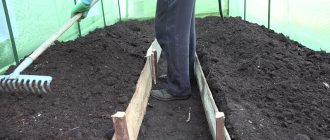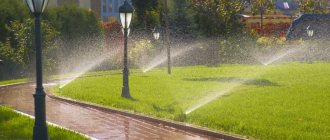When arranging parks and adjacent areas, space is allocated for a luxurious lawn. This exterior element performs not only an aesthetic function, but also a practical one. Lawn grass cleanses the soil of harmful microorganisms, improves the microclimate of the site, and helps increase air humidity. To obtain a thick green canvas, high-quality soil preparation for the lawn is necessary.
Lawn site requirements
The first step is to determine the location for the lawn. When looking through different options, it is worth considering that the site should be well illuminated by sunlight.
Advice! When choosing a place for a lawn, you need to take into account what kind of irrigation will be used and its operating mode. Light shading near the site in the form of tall trees or a fence would not hurt. Otherwise, the scorching rays will burn the grass.
Another criterion is the cardinal direction. The microclimate depends on which side the site is located on. If the choice fell on a site located from the east or north, the lawn will be blown by a cold wind, from the west or southwest - by a damp wind. The southern direction is fraught with increased dryness, the northern - excess shade.
In this case, you need to focus on the type of lawn. A flat grass carpet is not dangerous from cold wind, but excess moisture and deep shade can destroy it. For tall lawn plants, it is better to choose areas that are not blown by the wind, otherwise the appearance will be spoiled due to the grass laid in different directions.
An equally important role when choosing a site is played by the type of soil and the level of groundwater. Too dense soils are lightened with a mixture of peat and sand, loose soils are enriched with fertile soil. When groundwater occurs close to each other, it becomes necessary to develop a drainage system.
What places are not suitable for a lawn:
- in the lowlands;
- in marshy areas;
- on a relief area with large slopes;
- in close proximity to tall trees.
Do not despair if the available free space for a lawn does not meet the above criteria. By adhering to the rules for preparing the soil for sowing grass, you can correct any flaws and shortcomings.
Leveling the area
A flat lawn looks lovely, but on an uneven lawn some (high) areas will be cut almost bare, while on low areas the grass will be too long, which does not look particularly beautiful. Dealing with hummocks and depressions will be much more difficult once the grass has grown, so take the time to do it now. Do this work with all care and keep in mind that as the ground settles, the unevenness will appear again.
After digging, walk around the entire area with a rake, select stones, old roots, and so on from the surface. Step aside often and check the level of the area from different points. Level the highest and lowest areas by moving soil from the former to the latter.
After leveling, it is necessary to trample the ground and thus create a layer in which grass or rolled turf can take root well. After this, thoroughly level the area again.
What you need to prepare the soil for a lawn with your own hands
When developing landscape design, you should think about the layout for the lawn. If you plan to sow a large area with grass, you need to make smooth slopes (about 30 degrees). This will prevent moisture stagnation after prolonged rainfall.
If the area for the lawn is embossed, you need to plan the area to eliminate sharp transitions. This stage should not be ignored, otherwise the passage of the lawnmower will be difficult.
When initially developing a project, it is important to consider the shape and location of the lawn. The site is chosen taking into account insolation. Greens develop well in the sun. The shape is chosen as desired, the main thing is that there are no sharp corners or zigzags. The complex configuration of the object will complicate the cutting procedure.
In addition to the lawn itself, it is necessary to provide approaches to it, fencing, and lighting.
Reference! If you plan to mow using a machine, the paths are arranged below the level of the grass area.
To prepare the soil for your lawn yourself, you need to consider the following factors:
- the place for sowing grass is arranged with a slight slope;
- the work is carried out using cultivation equipment and garden tools (a minimum set of equipment will be required when choosing a small site);
- carry out activities according to the planned plan; you should not neglect weeding, digging or compaction, otherwise the efforts will not be crowned with success.
Approximate work plan for soil preparation
- Clearing the area of large debris.
- Digging while simultaneously selecting weeds with roots, stones, stumps and other plant debris from the soil.
- Increasing soil fertility by applying fertilizer, lightening the soil, neutralizing acidity. In some cases, it is necessary to replace the top layer of soil (10-15 cm).
- Leveling the site.
- Weeding for 2-4 weeks. It is impossible to leave the area unattended before sowing.
Experienced gardeners do not recommend treating the area with herbicides, especially if the local area is chosen as the location for the lawn.
What types of lawns are there?
Gardeners count 4 types of lawns:
- English, or parterre;
- gardening;
- meadow;
- Mauritanian;
- sports.
Of these, only English is intended for decorative purposes. You cannot lie on it, play, or have picnics. Needs regular care: cutting, watering, feeding with fertilizers. The herbal mixture is expensive compared to others. Only ideal soil preparation for the lawn can ensure even cutting of the grass carpet. Even a small bump or hole will be clearly visible from afar.
Landscape gardening is more resistant to stress, has a certain composition of grasses, and is not afraid of shading from trees, cold, or prolonged rains. It is cheaper to set up and maintain compared to English. Most often used in dachas.
For your information! Meadow is more resistant to stress, easy to care for, and also has a specific composition of herbs. Suitable for home lawns and large areas, does not require frequent mowing of the grass. It contains herbs that bloom all summer long.
Mauritanian differs from the others in the abundance of flowering herbs. They are pleasing to the eye all summer long. They are mowed only after all the flowers have withered: in late summer and autumn. Does not require any care other than watering in dry summers and mineral fertilizing.
The sports one differs from the others in the composition of the herbs. They are selected in such a way that it is not afraid of heavy loads. The lawn is not afraid of trampling and is specially designed for sports fields. You can play football on it, have picnics, or just relax, but it is very demanding to care for. It needs to be watered regularly and mowed weekly.
When to do it
It is better to start preparing the area for a lawn in the fall. During the cold season, the earth will become compacted, and all the flaws and unevenness of the site will become visible. When organizing work in the spring, you should walk on the ground with a hand roller.
The advantage of autumn preparation is the opportunity to carry out the full range of recommendations:
- soil analysis to determine its type and fertility;
- alkalization of acidified soil (introduction of lime powder);
- relief of high density soil (peat, compost and sand are used);
- destruction of weeds by treating the site with chemicals (in spring, sowing after the use of herbicides is allowed no earlier than 4-5 weeks).
The land can be prepared at any time during the warm season. However, it is not advisable to do this in the summer, since before sowing the lawn grass, the area will be covered with a carpet of weeds. The optimal time for completing the work is autumn, the first months of spring (if climatic conditions allow).
Site clearing
Using pegs, string and sand lines, draw a layout of the lawn at the planned location. Now it's time for some hard physical work. First of all, you need to clear the area of all previous inhabitants: bushes, trees and flower beds.
If grass is already growing in the area intended for the lawn, you will have to get rid of it. This can be done in two ways: remove the top layer of turf with a bayonet shovel (while trying to capture as little soil as possible) or destroy the grass using herbicides. If you choose the first method, the removed turf can be turned into a valuable source of fertile soil; With the second method, you will have to wait 6-8 weeks before sowing new grass or laying turf. Weeds that appear on the site during this time must be weeded out or also treated with herbicides.
All other coverings of the area intended for lawn, such as concrete, stone or brick, will have to be completely removed, including the solid foundation underneath. This is hard work and you may need to hire help for it. Old blocks, stones or slabs can be saved and used elsewhere, but the concrete will have to be mercilessly broken.
On a note
- Work methodically and make sure that you don't leave any un-dug areas. Never dig in wet weather: it is difficult and you will also compact the soil unnecessarily.
- To turn the removed turf into fertile soil, turn it upside down and place it in a brick-like pile somewhere in the far corner of the garden. In six months or a year, the grass will rot, and you will get completely fertile soil.
- With the help of digging, you can improve almost any area. Rocky soil will need to be thoroughly loosened with a rake so that the grass grows on a flat surface.
How to properly prepare the soil step by step
Step-by-step soil preparation, taking into account the recommendations of specialists, is the key to high-quality work on organizing a lawn.
Cleaning the area and removing weeds
Not everyone is inspired by cleaning the site for an object. Despite the lack of enthusiasm, this is a significant contribution to a future landscaping project. Rubbish, weeds, and stones must be removed from the site.
This proximity prevents the roots of lawn grass from developing normally. Weeding is recommended to be done after heavy rains. This is the ideal period to remove the long root system of the weed from the ground. In addition, the soil is easily shaken off the root fibers.
For more thorough cleaning, digging up the soil is required. This is done using a cultivator or an ordinary shovel. The goal is not only to loosen the soil, but also to re-clean up weeds and other debris. High-quality work minimizes the risk of the lawn becoming overgrown with a carpet of weeds.
Advice! After digging up the area, it is recommended to walk through it again to remove any missed weeds.
Alignment
After the initial digging, the surface of the territory is covered with large fragments of soil. In the absence of rain, they turn into impenetrable cobblestones in a couple of days. Therefore, immediately after cultivation, leveling is carried out. The essence of the procedure is to pass through the area with a rake. The purpose of the event is to break the clods down to the wheat grain fraction, to even out the differences and mounds.
The entire process of preparing land for a lawn on large areas is carried out with a motor-cultivator or walk-behind tractor.
Use a large board to level the surface. It is attached to cables or chains on both sides of a simple device. All that remains is to drag the board across the area to trim the tubercles.
Digging
The next step is thorough digging. This type of work can be single-tiered or double-tiered. The first option is used for cultivating previously cultivated land. If the soil has not been cultivated for a long time, use the second method.
Single-tier digging is carried out to the depth of the spade bayonet. In this case, only the top layer of soil is prepared, the bottom remains the same. Experienced gardeners advise combining this process with the introduction of rotted compost or manure.
Features of performing two-tier digging:
- make a groove across the area for 1 bayonet of a shovel (the earth needs to be moved aside for a while);
- using a fork or pick, thoroughly loosen the lower level of the soil;
- parallel to the first furrow, make a second one, pour the excavated soil into the first furrow;
- To seal the first furrow, take soil taken out from the first groove.
The work is done with special diligence. It is important to immediately break large lumps with a tool, preventing them from drying out.
Important! Dense clayey terrain requires drainage. You can make a drainage system in the process of two-tier digging.
Formation
The right lawn can have slight slopes (up to 30 degrees) with smooth transitions. This will ensure unhindered passage of the lawn mower and prevent moisture stagnation during heavy rains.
During the initial arrangement of the lawn, its shape and location for the object are carefully thought out. When choosing a site, you should give preference to the sunny side. It is better to avoid a complex perimeter shape, as this will complicate further lawn grass care, especially cutting.
Drainage
The need for drainage arises when processing clay soils. The dense structure prevents the normal development of the root system of lawn grass and provokes rotting when moisture stagnates. Water from precipitation should flow freely deep into the soil.
Drainage will help to establish this process. To organize it, a two-tier digging is used. Instead of soil, gravel or crushed stone of a fraction of no more than 2.5 cm should be added into the grooves of the lower layer.
Loose soils do not need a drainage layer.
Fertilizer application
You can increase the fertility of the soil by adding compost or sand to it. The first option is suitable for sandy soil, the second - for heavy soil. 1-2 weeks before sowing, the lawn area is fertilized with complex mineral compounds. They are sealed with a rake in the top layer.
Reference! If the soil is depleted, the top layer 10-15 cm thick is replaced. Garden soil is used as a replacement.
Seal
Just before sowing, the soil is compacted with a hand roller. The weight of the device should be 100-150 kg. An alternative option is a log. When processing a small area, you can use a board. It is placed one by one on the soil and several passes are made. Under the weight of its own weight, the earth becomes compacted.
After completing work, you should not walk around the site so as not to disturb the soil structure. A couple of days before sowing, the site is thoroughly irrigated.
Compacting should be done in dry weather. The soil should also be dry.
Stage 6: Laying electrical wiring on site
This stage is recommended to be done in the fall. Then, before spring, the earth will have time to settle, and it will be possible to fill up the formed depressions, and then lay out a lawn or plant plants whose roots do not penetrate too deeply into the soil: perennials and small shrubs.
When laying wires around the site, they are first laid in plastic pipes and placed in pre-dug trenches 60-70 cm deep. The places where they are laid should be marked with signal tape made of film or bricks (15-20 cm above the cable).
In this case, any electrical equipment placed on the site (sockets, lamps, transformers) must have sealed housings protected from dust and moisture (minimum degree of protection IP 55). And home lighting (intended for use inside buildings) cannot be used on the site, even to illuminate canopied terraces and gazebos. Since their parameters and protection do not provide for outdoor use.
Please note that high-voltage equipment (220 V) can only be designed and installed by specialists who have the appropriate permit - permission to perform electrical installation work.
Low-voltage equipment (12 or 24 V) can be installed on the site yourself. Here you will need a step-down transformer. It is best to lay such wires at a depth of at least 30 cm (so as not to cut them with a spade while digging up the ground), or along the surface of the ground.
You should remember about safety precautions. Firstly, the cables should not intersect with gas and water pipes. Secondly, they should be laid as far as possible from already growing trees and shrubs. And although there are no rules regulating this point, it is believed that 50 cm from the edge of the projection of the crown of a tree or bush to the place where the cable is laid is sufficient.
Features of soil preparation for laying rolled lawn
The process of preparing the soil for laying a rolled lawn does not differ significantly from the procedure before sowing. The algorithm of activities includes:
- analysis of the landscape of the site to select an area for a lawn;
- cleaning the soil from weeds, debris and stones;
- leveling the soil - creating a slope of more than 5 cm (this will help to spread the rolls efficiently and prevent moisture stagnation);
- removal of the top layer in order to remove the dead layer that is not capable of nourishing the grass cloth;
- adding a fertile layer (from 10 cm) followed by leveling using garden tools.
The survival rate of rolled grass depends on the quality of the preparatory work.
First haircut
To protect the seeds from the wind, birds or rodents, it is necessary to cover the ground with a light non-woven fabric (film, light tarpaulin). It will not only protect the crops, but also help retain moisture in the ground, acting as a greenhouse.
Even when the seeds have sprouted and taken root, do not water the lawn with a hose without a sprayer - the powerful pressure can easily damage the structure. To water the lawn, it is preferable to use automatic sprinkler systems with fine sprayers.
The first shoots appear after 14-20 days, depending on the type of lawn grass. When the young grass reaches 5-6 cm, roll the surface with a light roller. The fact is that seedlings slightly raise the soil, and it must be well compacted. Don’t worry about the condition of the shoots - in a couple of days they will rise and delight you with their juicy greenery.
When the grass grows a little more and reaches 8-10 cm, carry out the first mowing of the lawn. Remember to leave at least 5 cm of grass.
The lawn may seem sparse after the first mow, but be patient. In just a month or a month and a half, the grass will fully grow, and your site will become more beautiful than any photo from a landscape design magazine!
The lawn requires constant care, otherwise it will quickly lose its beauty. Trim the grass every week, keeping it from growing higher than 5-6 cm.
Remember, preparing the soil for a rolled lawn follows exactly the same principle as for sowing. It is necessary to carefully approach each stage of preparation in order to subsequently avoid problems and enjoy your ideal green area!
Price
In the process of planning a lawn, it is worth considering the cost of preparing the land for sowing. The price depends on several factors:
- who is the performer (with your own hands or using a specialized team);
- scope of work;
- the degree of neglect of the site, the presence of unevenness, the type of soil.
The cost of soil preparation work also depends on the volume of the area:
- up to 6 acres – 42,000 rubles;
- up to 8 acres – 56,000 rubles;
- up to 10 acres – 70,000 rubles;
- up to 20 acres – 84,000 rubles.
If work is to be done on difficult soils, prices increase by 10-12%
Reference! When performing activities with your own hands, the costs used are mainly labor. You will only have to spend money on the missing equipment and chemicals if you decide to use them to treat the land against weeds.
Cleaning the lawn
Cleaning the area involves clearing the area of foreign debris such as small stones, branches, stumps and other things. Remember that such garbage should not be buried, as this will negatively affect the development of the lawn’s root system. If the soil for your future lawn has already been used and any garden plants are growing on it, all you need to do is level the surface of the soil and clear it of vegetation.
The advantage of this situation is that there is no need to improve the soil, and this will save a lot of time. If nothing grows on the site and the land has not been cultivated, you will need to work hard to create all the necessary soil conditions.
First, assess the condition of the soil and its quality. Neutral soil for a lawn is medium-weight soil of average fertility. If the soil on your site does not fit the description, you must manually add all the necessary substances to the soil, mix it and then weed the entire area allocated for the lawn.
The composition of the soil should be as follows:
- Heavy loam – 20%, but may vary
- Content of rotted manure and/or compost – 20%
- Peat content – 30%
- Sand content – 30
You need to maintain these proportions as much as possible.
- If the soil is poor, add humus and peat.
- If the soil is heavy, you need to add more sand and peat
- If the soil is sandy, add more organic materials, as well as loam.
- To improve soil quality, you can add regular superphosphate at a rate of 40~50 grams per square meter.
The fertile layer must be at least 30 centimeters. Under such conditions, the root system will develop normally. If you are going to lay a rolled lawn, 20 centimeters will be enough. So that the soil does not vary greatly in mass, dig it thoroughly. This stage is very labor-intensive and takes a lot of time and effort.
To effectively mix the different components of your soil, a two-tier dig will help you. The principle of the device is that the soil that was removed from one furrow was poured into the adjacent one, then vice versa. Pay attention to large clods and break them up.
At the end of all work, the soil should be shallow. On average, lumps of soil should not be larger than a pea. To check the levelness of the area, you will need a small board and a rope: secure the rope to the edge of the board and drag it along the ground. After all of the above, you can finally start sowing for the first time, or laying a rolled lawn.
0800
Deadlines
The optimal time for preparatory work is the months: from May to October. This is the period when, upon completion of cleaning and shaping the area, you can begin sowing. If you delay planting lawn grass, after 3-5 days weeds will appear on the surface. Therefore, experts do not recommend prolonging the lawn arrangement.
The time required for preparation depends on several factors:
- soil type;
- neglect of the site;
- area.
It is possible to cope with preparing the soil for sowing lawn grass in 2-4 days (area 400-800 m2). Specialized enterprises offer to carry out complex work within 1-2 days.
If you have any questions regarding the arrangement of your lawn, it is advisable to seek advice and assistance from companies offering this type of service.
When preparing the land, you can do without compaction
- If you couldn’t find a tamper, but you don’t want to spend 5,000 on a purchase, then do this . 1 person loosens the soil with a metal rake, and the second person waters it with a hose. The earth is settling and compacting very well. 2-3 passes are enough to make the base dense and suitable for sowing seeds.
Aleksej2000:
Level and water at the same time. Sits down thoroughly.
Source www.forumhouse.ru
- It is not necessary to remove the top of the soil . If the area is small, first work it well with a metal rake to remove all the stones and other contaminants. Then scrape the surface with a fan rake, then prepare the area as usual.
genazvale:
This is all, of course, ideal. When there is enough money. I have the same plot of lawn and flowers. Small, though 18x3 m. I cleaned it myself. First, I went through it with a rake a couple of times, then 4 times with a fan rake (like a broom), then I leveled it with soil from a neighboring plot and sowed it with a lawn. It's growing beautifully. Flowers, trees, grass - a song. Although it was so dirty that it was impossible to dig it up.
Source www.stroimdom.com.ua
Drainage system and lawn arrangement
In areas with dense clay soil located in lowlands, water remains standing for a long time after rain. In such conditions, lawn grasses will become sick, so drainage needs to be installed in the area.
The drainage pad is laid during the digging process:
- remove the top part of the soil with a strip of small width;
- the bottom layer to the depth of a shovel in this strip is also removed and replaced with a sand and gravel drainage layer;
- form a second strip nearby, pouring the outer part of the soil from it into the first strip on top of the drainage cushion;
- change the lower part of the soil in the second strip to a sand and gravel cushion and fill the outer layer on top of it, removed when forming the first strip;
- The entire area is treated in the same way.
As a result, a section is obtained in which the upper fertile layer is located on a substrate with a high filtration coefficient. The water will no longer stagnate here.
How to make a tamper yourself
A tamper can be made from an empty barrel
Make a tamper out of a barrel:
- Find a container with a volume of about 40-50 liters. Any metal barrel will do, the main thing is that it is not full of holes and that it has a cork.
- Pour in 30-40 liters of water. It is not necessary to fill it completely. You need a weight of about 40 kg for good soil compaction. Place the element on its side, as in the photo.
- Use as a tamper. Just roll the barrel around the area. Large 200 liter options are not suitable, as they are inconvenient to roll.
Video: In a video example, the author talks about how he used a barrel of water for tamping - he simply rolled the soil. He says that within 500-800 rubles you can take a container, pour water into it and roll the soil











